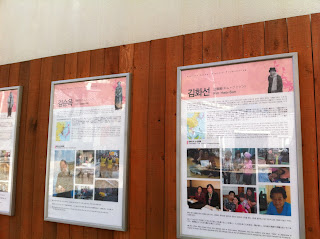 |
| Art therapy has helped many of the Halmoni express their testimonies |
From 1932 until the end of World War II, the Japanese military held women as sex slaves all over Asia. An estimated 200,000 girls and women, mostly Korean, served as sexual slaves in the military's brothel system. These women, often referred to as "comfort women" were raped, abused, starved, tortured and many of them were also killed. Towards the end of the war, many were massacred or abandoned by military personnel throughout Asia.
After years of silence, this issue was brought into the public spotlight in 1991 and since then, 220 former "comfort women" in South Korea have come forward. These women are called Halmoni which means granny in Korean. To this day, the Japanese government still denies its involvement in the abduction of these girls and women and the organized system of "comfort stations."
Every Wednesday at noon since January of 1992, survivors gather outside of the Japanese embassy here in Seoul to protest the government's denial of its role in military sexual slavery. The government has also refused to meet the demands of the victims. Today, many Halmoni and human rights activists continue to attend the weekly demonstrations. I hope to attend and support these modern-day abolitionists before I leave Korea.
To know more about this issue visit www.houseofsharing.org. To find out how you can help combat slavery, visit www.notforsalecampaign.org.
Give me your eyes for just one second
Give me your eyes so I can see
Everything that I keep missing
Give me your love for humanity
Give me your arms for the broken hearted
The ones that are far beyond my reach
Give me you heart for the ones forgotten
Give me your eyes so I can see
-Brandon Heath
 |
| Biographies of the Halmoni |
 |
| A sculpture representing the desired lives of these women: whole and with a family. |
 |
| A sculpture representing the actual lives of these women: suffering and incomplete |
 |
| Statues of the Halmoni |








